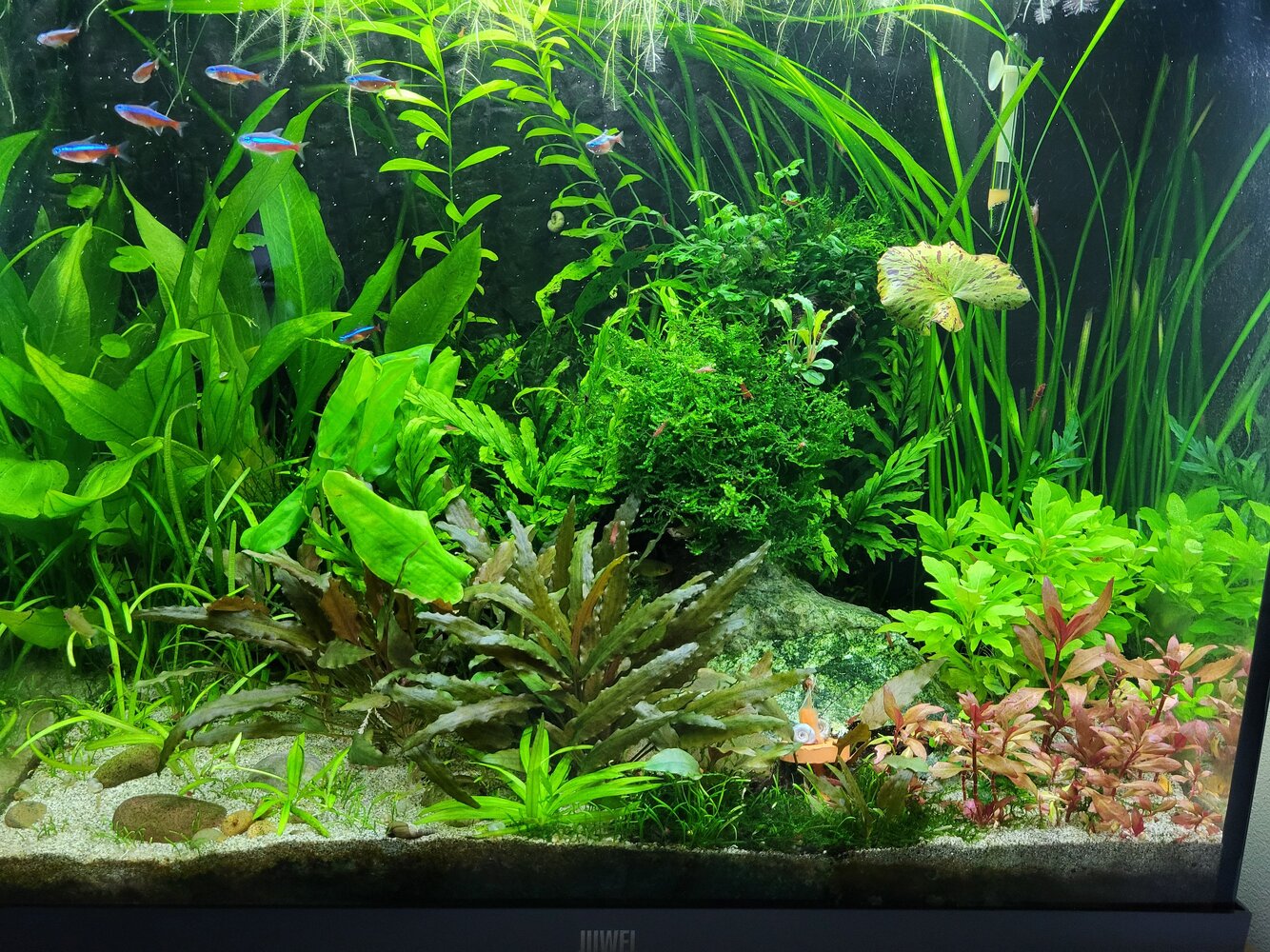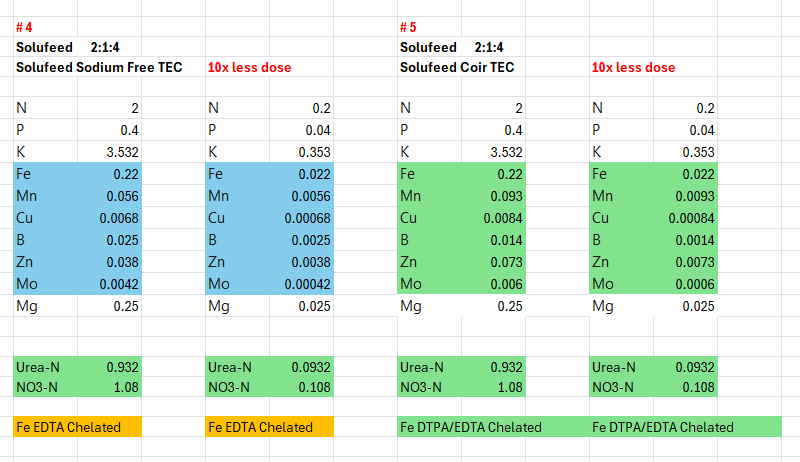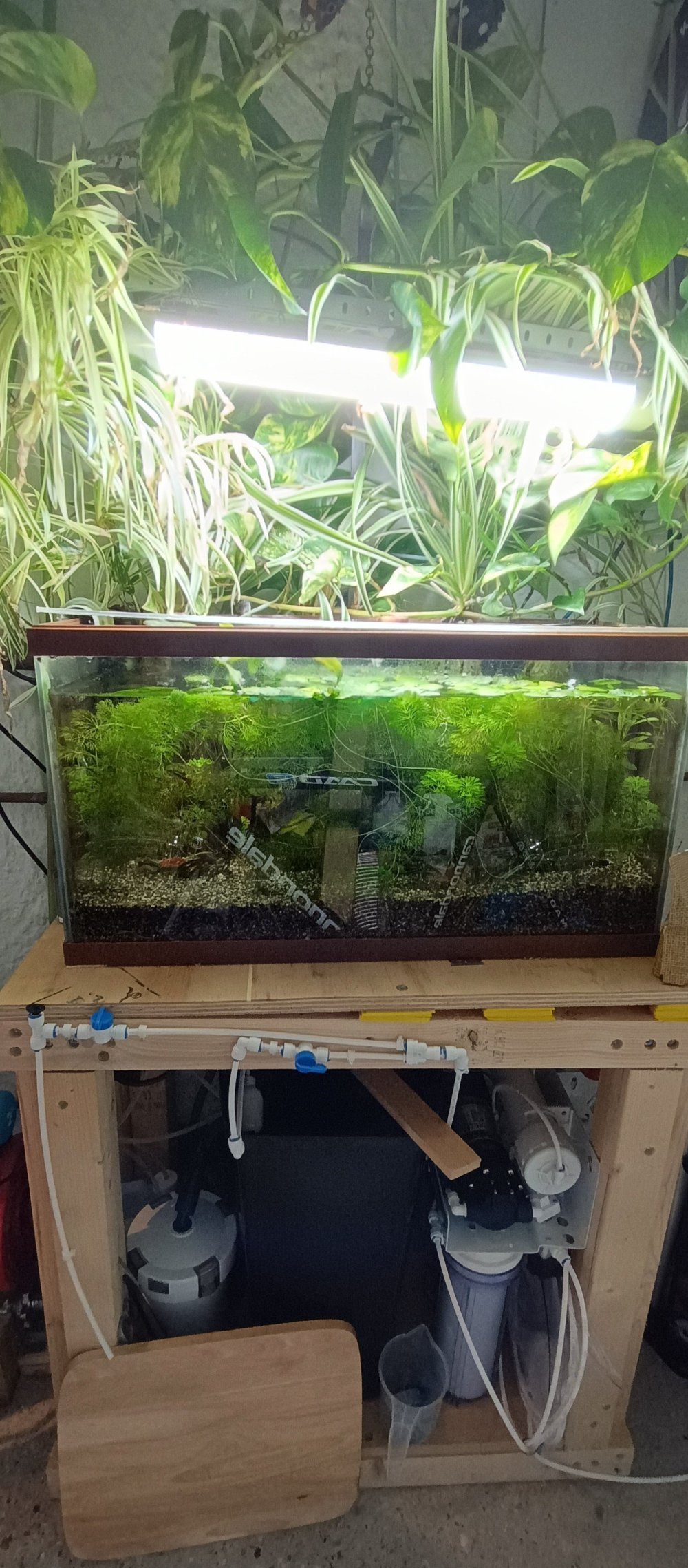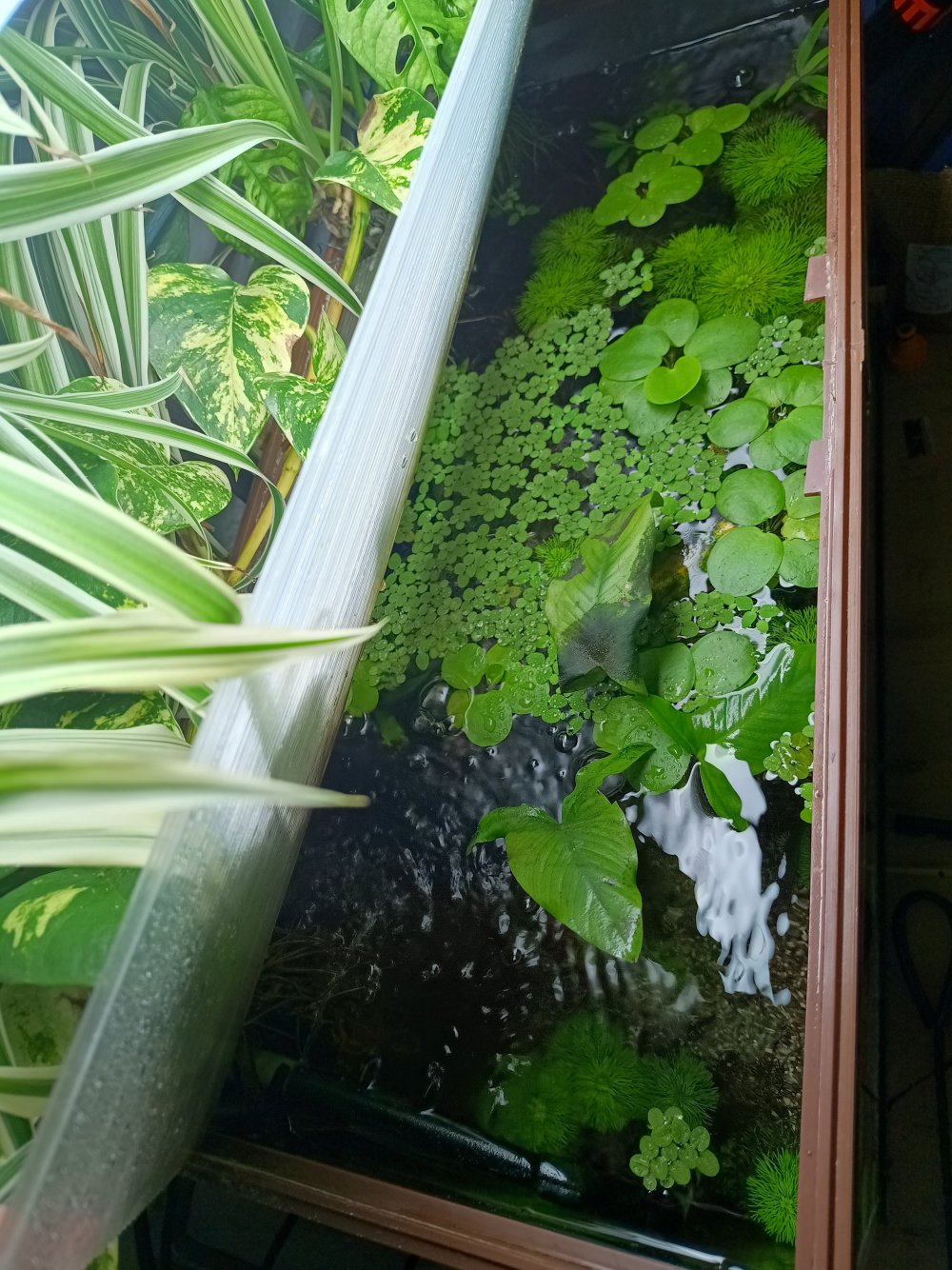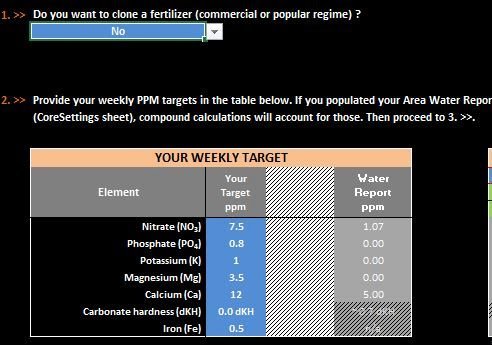Hi Cazza, do you have some pictures to share?A little update.... been using the mix for around 10 days now, and the plants are loving it! It seems to be even better than the TNC Complete it replaced, with everything growing very well. Very happy with @Happi! Thank you!
-
You are viewing the forum as a Guest, please login (you can use your Facebook, Twitter, Google or Microsoft account to login) or register using this link: Log in or Sign Up
You are using an out of date browser. It may not display this or other websites correctly.
You should upgrade or use an alternative browser.
You should upgrade or use an alternative browser.
Solufeed 2:1:4 and Solufeed Sodium Free TEC or Solufeed Coir TEC Combination
- Thread starter Happi
- Start date
Cazza
Member
Lincs Planter
Member
Thanks @Happi much appreciated due to start the system up after I've had time to nip to Aquarium Gardens and collect plants. Will be running quite high CO2 for the first three or four weeks and then slowly drop it back down. So dose the above three days out of every six and then water change on the 7th?
Cheers
Cheers
Lincs Planter
Member
Is it best to split these into smaller doses and dose every day or to split the macro and micro or doesn't it make any difference?
jaisol
Member
A similar dry fertilizer to solufeed 2-1-4 is elixier garden supplies high-potassium-fertiliser, Cheaper .. and available on ebay, the declarations read the same

 elixirgardensupplies.co.uk
elixirgardensupplies.co.uk
High-potassium-fertiliser
solufeed 2-1-4

Bumper Crop High Potassium Fertiliser | N.P.K: 15-5-30+3Mg |
Bumper Crop High Potassium Fertiliser | 700g-20kg Weights Available | Perfect for Fruiting & Flowering Plants.
High-potassium-fertiliser
| Total nitrogen (N) | 15.0 |
| Nitrate nitrogen (N) | 8.1 |
| Ammoniacal nitrogen (N) | – |
| Ureic nitrogen (N) | 7.0 |
| Phosphorus pentoxide (P2O5) | 6.9(P:3.0) |
| Potassium oxide (K2O) | 32.0(K:26.5) |
| Magnesium oxide (MgO) | 3.0(Mg:1.9) |
| Boron (as polyborate) | 0.021% |
| Copper (as EDTA) | 0.010% |
| Iron (as EDTA) | 0.175% |
| Manganese (as EDTA) | 0.060% |
| Molybdenum (as molybdate) | 0.005 |
| Zinc(as EDTA) | 0.075 |
[th width="49.6997%"]
Nutrient
[/th][th width="49.6997%"]Content(%)
[/th]| Nutrient | Content (%) |
| Total nitrogen (N) | 15.0 |
| Nitrate nitrogen (N) | 8.1 |
| Ammoniacal nitrogen (N) | - |
| Ureic nitrogen (N) | 7.0 |
| Phosphorus pentoxide (P2O5) | 6.9 (P:3.0) |
| Potassium oxide (K2O) | 32.0 (K:26.5) |
| Magnesium oxide (MgO) | 3.0 (Mg: 1.9) |
| Boron (as polyborate) | 0.021 |
| Copper (as EDTA) | 0.010 |
| Iron (as EDTA) | 0.175 |
| Manganese (as EDTA) | 0.060 |
| Molybdenum (as molybdate) | 0.005 |
| Zinc (as EDTA) | 0.075 |
| Calculated EC at 1 gram per litre | 1.1475 mS |
Hi,
Presumably 412 never gets a mention because of the high Urea and low Nitrate content but I can't help wondering if it may or may not be a better option for daily lean dosing in a soft water CO2 injected tank, I wouldn't really want a ratio of 1-2 Nitrogen-Potassium although I know people are having great success using the 214. Possibly better still, what about a 50-50 mixture of 214 and 412?
I have been curious to ask this since the threads inception and I'm interested in peoples views/input.
Attached are the two products composition sheets for comparison.
Cheers!
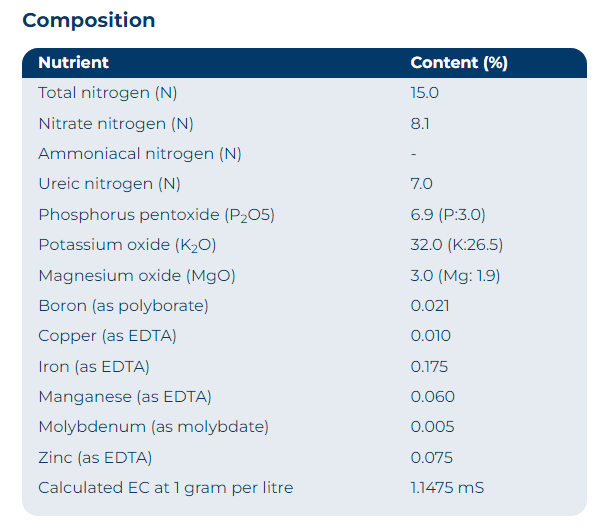
Presumably 412 never gets a mention because of the high Urea and low Nitrate content but I can't help wondering if it may or may not be a better option for daily lean dosing in a soft water CO2 injected tank, I wouldn't really want a ratio of 1-2 Nitrogen-Potassium although I know people are having great success using the 214. Possibly better still, what about a 50-50 mixture of 214 and 412?
I have been curious to ask this since the threads inception and I'm interested in peoples views/input.
Attached are the two products composition sheets for comparison.
Cheers!


Hi all,
I also felt that the 2 : 1 : 4 formulation was more widely applicable to people, including those people who had <"fish tanks with plants">, rather than <"planted tanks with fish">.
cheers Darrel
I think it might be a better option, I know @Zeus. has regularly microdosed urea (CO(NH2)2) without any issue.I can't help wondering if it may or may not be a better option for daily lean dosing in a soft water CO2 injected tank,
I'm pretty sure <"some plants will do much better"> with more urea. I'd guess it is the <"Orchid / Tomato dichotomy"> and somewhere there maybe a happy medium <"where both will grow">.Possibly better still, what about a 50-50 mixture of 214 and 412?
....... If I wanted to create a fertiliser that produced a pretty instant greening response, it would be something with a lot of nitrogen, and probably in the form of urea, to reduce the risk of <"fertiliser burn"> in terrestrial plants ......
That was what initially <"put me off">. When I didn't have any livestock <"I used Miracle Gro">, and the plants did really well.Presumably 412 never gets a mention because of the high Urea
I also felt that the 2 : 1 : 4 formulation was more widely applicable to people, including those people who had <"fish tanks with plants">, rather than <"planted tanks with fish">.
I thought the fish might supply some fixed nitrogen and if they used tap water as well it could be a "triple whammy" of nitrogen....... With efficient mechanical and biological filtration you can keep fish at <"insane stocking rates">, <"even without plants"> and <"we have plants">.
cheers Darrel
Last edited:
A similar dry fertilizer to solufeed 2-1-4 is elixier garden supplies high-potassium-fertiliser, Cheaper .. and available on ebay, the declarations read the same

Bumper Crop High Potassium Fertiliser | N.P.K: 15-5-30+3Mg |
Bumper Crop High Potassium Fertiliser | 700g-20kg Weights Available | Perfect for Fruiting & Flowering Plants.elixirgardensupplies.co.uk
High-potassium-fertiliser
Total nitrogen (N) 15.0 Nitrate nitrogen (N) 8.1 Ammoniacal nitrogen (N) – Ureic nitrogen (N) 7.0 Phosphorus pentoxide (P2O5) 6.9(P:3.0) Potassium oxide (K2O) 32.0(K:26.5) Magnesium oxide (MgO) 3.0(Mg:1.9) Boron (as polyborate) 0.021% Copper (as EDTA) 0.010% Iron (as EDTA) 0.175% Manganese (as EDTA) 0.060% Molybdenum (as molybdate) 0.005 Zinc(as EDTA) 0.075
[th width="49.6997%"]
Nutrient
[/th][th width="49.6997%"]
Content(%)
[/th]
solufeed 2-1-4
Nutrient Content (%) Total nitrogen (N) 15.0 Nitrate nitrogen (N) 8.1 Ammoniacal nitrogen (N) - Ureic nitrogen (N) 7.0 Phosphorus pentoxide (P2O5) 6.9 (P:3.0) Potassium oxide (K2O) 32.0 (K:26.5) Magnesium oxide (MgO) 3.0 (Mg: 1.9) Boron (as polyborate) 0.021 Copper (as EDTA) 0.010 Iron (as EDTA) 0.175 Manganese (as EDTA) 0.060 Molybdenum (as molybdate) 0.005 Zinc (as EDTA) 0.075 Calculated EC at 1 gram per litre 1.1475 mS
Hi,
Presumably 412 never gets a mention because of the high Urea and low Nitrate content but I can't help wondering if it may or may not be a better option for daily lean dosing in a soft water CO2 injected tank, I wouldn't really want a ratio of 1-2 Nitrogen-Potassium although I know people are having great success using the 214. Possibly better still, what about a 50-50 mixture of 214 and 412?
I have been curious to ask this since the threads inception and I'm interested in peoples views/input.
Attached are the two products composition sheets for comparison.
Cheers!View attachment 222354View attachment 222355
Just for comparison:

as you can see why I choose to Mix one or the other, #4 and #5 are likely your best options, #4 and #5 can be used in both soft or hard water but #5 will be superior due to its DTPA Fe Chelation, especially for hard water.
Recipe for #3 in case

SplantedTanx
New Member
I have just about depleted my current fertilizer and noticed this easy Mix via @Happi and I would really like to try it out. I am going to order Solufeed Coir Tek and the 2:1:4 as listed. I will go for the #5 option and come back to you all with the results. I have a 200ltr fully planted tank and I will be micro dosing daily. I keep lots of nano fish so I am just checking up here to see if the Solufeed 214 and Coir Tek will be fine for these little nano fish I keep ? As I have noticed the Urea in it etc. My water parameters is basically the same as @bazz
Thanks all 😉
Thanks all 😉
I've read all 9 pages and am non the wiser on this 🙁
So i understand theres a couple of products that can make an all in one solution. But which recipe is right and what is it based on?
I'm looking to move from the dry ferts i've been using for years as they are becoming increasinlgy hard to come by.
Could anyone summarise this for me?
Yours,
A complete numpty.
So i understand theres a couple of products that can make an all in one solution. But which recipe is right and what is it based on?
I'm looking to move from the dry ferts i've been using for years as they are becoming increasinlgy hard to come by.
Could anyone summarise this for me?
Yours,
A complete numpty.
Hi all,
Commercial fertilisers aren't like aquarium ones, they have a quantifiable end result (a crop yield) and a bottom line.
Starting from a mix is less fully customisable than using "dry compounds", but we know that Solufeed "works" because it is a commercial mix designed for horticulture. If it didn't "work"?, or wasn't cost effective? The "Solufeed" manufacturer would have become insolvent long ago.
cheers Darrel
Yes.So i understand theres a couple of products that can make an all in one solution
So @Happi used his extensive knowledge of nutrient solutions to produce a mix of the two solufeed products that closely replicated an "ideal" ratio of plant nutrients.But which recipe is right and what is it based on?
Commercial fertilisers aren't like aquarium ones, they have a quantifiable end result (a crop yield) and a bottom line.
Starting from a mix is less fully customisable than using "dry compounds", but we know that Solufeed "works" because it is a commercial mix designed for horticulture. If it didn't "work"?, or wasn't cost effective? The "Solufeed" manufacturer would have become insolvent long ago.
All you need to do is follow the recipe, and just change the volume of solution added dependent upon the size of your tank, so 10 ml for a 90 litre tank etc. You can dose a set amount (lean dose or EI etc.) or use the <"Duckweed Index">, it is infinitely flexible.The difference between <"aquarium"> and commercial horticultural fertilisers is that horticultural fertilisers have to work.
In horticulture no one can get away with selling the <"World's most expensive water"> etc. If fertilisers didn't work, or weren't cost effective? No-one would buy them and the company making them would have gone out business. It is as simple as that.
rom my perspective 5.3 K is plenty for a weekly dose, we can adjust this if someone really want to add more. This dosing can be used in low or high tech setups just like EI style dosing. It is my advice to maintain lower PH less than 7.0 just to be safe while using a fertilizer that usually contain Urea or NH4. I use to dose Urea in PH above 7.0 water without any issue, but with extra precaution.
The recipe below is based on 50-gallon (189.27 liter) aquarium and you can adjust the dosing to your own tank if needed.
500 ml solution, 20 ml per 50 gallon
Step #1
start with 450 ml Distilled water
Step #2
Add 0.25 gram potassium sorbate and mix till fully dissolve
Step #3 (Pick one from the list below, White Vinegar is Preferred) and mix till fully dissolve
Add 0.25 gram sodium benzoate
Add 0.5 gram Ascorbic acid
Add 5-10 ml White Vinegar
Step #4
Add 31.545 gram Solufeed 2:1:4 and mix till fully dissolve
Add 5.721 gram Solufeed Sodium Free TEC and mix till fully dissolve
Step #5
after mixing all the chemicals, add distilled water to reach the 500 ml solution
20 ml per 50 gallon (189.3 Liter) dose will add the following:
N 1 (Urea-N 0.466 ppm, NO3-N 0.54 ppm) this adds about 2.4 ppm NO3, Rest of the N is from Urea
P 0.2
K 1.766
Fe 0.11166
Mn 0.02818
Cu 0.003446
B 0.0125
Zn 0.019
Mo 0.002146
Mg 0.1266
EI style 3x a week dose:
N 3 (1.4 Urea-N, 1.62 NO3-N) this will add 7.18 ppm NO3, Rest of the N from Urea
P 0.6
K 5.3
Fe 0.335
Mn 0.08454
Cu 0.01
B 0.0375
Zn 0.057
Mo 0.006438
Mg 0.38
cheers Darrel
Last edited:
It depends. I have a non-co2 tank with moderate light and I decided that I am targeting 7.5ppm no3 using Solufeed 2.1.4 and targeting 0.5ppm Fe using Solufeed Sodium-free Trace Elements Chelated ('TEC'). I find that that, plus patience, supports an awful lot of plant growth.which recipe is right and what is it based on?
The IFC is invaluable for working out how many grams of product to use in mixing your fertiliser to achieve your target no3 and fe.
Attachments
Duruma bağlı. Orta düzeyde ışık alan CO2 olmayan bir tankım var ve Solufeed 2.1.4 kullanarak 7,5 ppm no3 ve Solufeed Sodyumsuz İz Elementler Şelatlı ('TEC') kullanarak 0,5 ppm Fe hedeflemeye karar verdim. Bunun ve sabrın çok fazla bitki büyümesini desteklediğini görüyorum.
Gübrenizi karıştırırken hedeflediğiniz no3 ve fe'ye ulaşmak için kaç gram ürün kullanmanız gerektiğini hesaplamak için IFC paha biçilmez bir değere sahiptir.
but iron deficiency does not appear in floating plants, you cause something to accumulate, this can result in a negative resultIt depends. I have a non-co2 tank with moderate light and I decided that I am targeting 7.5ppm no3 using Solufeed 2.1.4 and targeting 0.5ppm Fe using Solufeed Sodium-free Trace Elements Chelated ('TEC'). I find that that, plus patience, supports an awful lot of plant growth.
The IFC is invaluable for working out how many grams of product to use in mixing your fertiliser to achieve your target no3 and fe.
Yes, the plants are doing ok for iron.
To reduce the chance of a negative result from accumulation I do weekly water changes, about 50% of tank volume, although I do miss a week every now and then...
As well as potential Fe accumulation there is also N, P, K accumulation which is why I don't dose EI levels of fertiliser... or looking again at Happi's recipe maybe I do ?? 😂
To reduce the chance of a negative result from accumulation I do weekly water changes, about 50% of tank volume, although I do miss a week every now and then...
As well as potential Fe accumulation there is also N, P, K accumulation which is why I don't dose EI levels of fertiliser... or looking again at Happi's recipe maybe I do ?? 😂
Last edited:
Thanks Darrel. So no need to take into account water reports or add additional chemicals like some recipes here? Incidentally, I water change with RODI water and do not add any remineralization salts on the basis that I'm adding enough magnesium in my weekly ferts and my Seriu stone gives off plenty of calciumHi all,
Yes.
So @Happi used his extensive knowledge of nutrient solutions to produce a mix of the two solufeed products that closely replicated an "ideal" ratio of plant nutrients.
Commercial fertilisers aren't like aquarium ones, they have a quantifiable end result (a crop yield) and a bottom line.
Starting from a mix is less fully customisable than using "dry compounds", but we know that Solufeed "works" because it is a commercial mix designed for horticulture. If it didn't "work"?, or wasn't cost effective? The "Solufeed" manufacturer would have become insolvent long ago.
All you need to do is follow the recipe, and just change the volume of solution added dependent upon the size of your tank, so 10 ml for a 90 litre tank etc. You can dose a set amount (lean dose or EI etc.) or use the <"Duckweed Index">, it is infinitely flexible.
cheers Darrel
In your water company's water report it gives the range of parameters over the year, so if you take the lowest value over the year stick it in the IFC and your tap and RO water volumes it will take it all into account and adjust to suit. Only issue you might have using an AOI salt mix is you cant reduce individual salts as easy - dependant on if your just using Solufeeds AIO and trace mixSo no need to take into account water reports or add additional chemicals like some recipes here?
I ordered all the bits I need to make Happi's Solufeed recipe this morning. I priced up the ingredients for the 3x weekly dose I need for EI dosing.
TNC Complete: £2.40
TNC replacement: £2.01
2:1:4/TEC S-F: 59p
I was going to go with the TNC replacement, but my parsimonious self made the final decision.
TNC Complete: £2.40
TNC replacement: £2.01
2:1:4/TEC S-F: 59p
I was going to go with the TNC replacement, but my parsimonious self made the final decision.
Yes, the plants are doing ok for iron.
To reduce the chance of a negative result from accumulation I do weekly water changes, about 50% of tank volume, although I do miss a week every now and then...
As well as potential Fe accumulation there is also N, P, K accumulation which is why I don't dose EI levels of fertiliser... or looking again at Happi's recipe maybe I do ?? 😂
It depends. I have a non-co2 tank with moderate light and I decided that I am targeting 7.5ppm no3 using Solufeed 2.1.4 and targeting 0.5ppm Fe using Solufeed Sodium-free Trace Elements Chelated ('TEC'). I find that that, plus patience, supports an awful lot of plant growth.
I don't see any major issues with accumulation if you are within that 7.5 ppm NO3 range but 0.5 ppm Fe from "TEC" might be bit on the higher range, but this is your choice and preference. you could also use #5 if Iron is your problem.
if anyone were to use this below, I do not see why they should fail. unless they are doing something wrong, if Iron is the main problem, they can use the #5
N 3 (1.4 Urea-N, 1.62 NO3-N) this will add 7.18 ppm NO3, Rest of the N from Urea
P 0.6
K 5.3
Fe 0.335
Mn 0.08454
Cu 0.01
B 0.0375
Zn 0.057
Mo 0.006438
Mg 0.38
in general, this is how the basic Protocol would look like :

This was in response to my 'variegated anubias' leaves. The new ones are now fully green.0.5 ppm Fe from "TEC" might be bit on the higher range, but this is your choice and preference.
Next time I make Micros I might go down to 0.4 and see how that goes. 🙂


